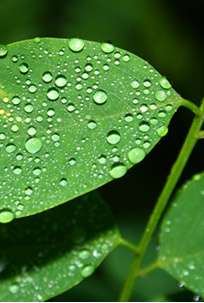Physicists saved from drowning in complexities of wetting theory

The relationship between a thin liquid film or drop of liquid and the shape of the surface that it wets is explained with a new simplified mathematical formula published this week in Physical Review Letters.
Understanding the precise interaction between liquids and surfaces is important for a number of areas, including the chemical industry and new nanotechnologies.
A mathematical formula is used to explain how the relationship between the liquid and the surface changes as one wets the other. Previous formulas have all failed to explain what scientists found when they conducted experiments in this field, and have become increasingly complicated and technical. .
Professor Andrew Parry from Imperial College London’s Department of Mathematics, author of the new paper, has devised and tested a new way to explain this process. His formula takes into account fluctuations in the drop of liquid between the solid surface it sits on and the air above it, which have not been included in any previous formula.
“Previous descriptions have all ignored or misrepresented these interactions and consequently were at odds with experimental results and computer simulations. The new formulation appears to explain all these outstanding problems in a very elegant manner," said Professor Parry.
The study of wetting focuses on the process by which a liquid makes a surface completely wet, such as occurs if a glass of water is poured over a glass surface. However, liquids do not always make surfaces completely wet, and droplets can form on the surface, such as when water is poured on a waxy material.
Scientists know that if the temperature increases these droplets can gradually flatten out, until the surface is completely wet, and is an example of a phase transition. Exactly how this transition to complete wetting takes place has been contested by physicists for 25 years.
Wetting is of key importance in many applications ranging from oil recovery and the way pesticides are deposited on plant leaves, to inkjet printing.
Professor Parry has been working on this problem for four years, and this paper is the final one in a series of three publications addressing this problem. Previously he devised the new mathematical model and now in this most recent publication he has proven that it works.
Source: Imperial College London




















